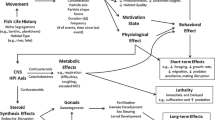Abstract
The acute effects of combined exposure to temperature increase and chlorination on a neritic marine copepod, Acartia omorii Bradford (collected offshore of Onjuku, Japan in 1982), were investigated in the laboratory. Continuous flow exposure and batch exposure modes were compared. Based on the results of continuous flow experiments, the 24-h median lethal concentration (24-h LC50, in mg l-1) of total residual chlorine was estimated using the multiple regression equation below, with a multiple correlation coefficient of 0.955: 24-h LC50=2.988-0.034 dT-1.611 log10 t where dT is temperature rise (°C) and t is exposure duration (min). In batch experiments, the predictive power of the multiple regression equation was reduced, probably due to variations in chlorine concentration during exposure duration.
Similar content being viewed by others
Literature cited
Bradley, B. P. (1978). Comparison of residual biotoxicity of chlorine and bromine chloride to copepods. Tech. Rep. No. 47, Water Resources Research Center, University of Maryland, College Park, Maryland
Carpenter, E. J., Peck, B. B., Anderson, S. J. (1974). Survival of copepods passing through a nuclear power station on northeastern Long Island Sound, USA. Mar. Biol. 24: 49–55
Coughlan, J., Davis, M. H. (1981). Effects of chlorination on entrained plankton at several United Kingdom coastal power stations. In: Jolley, R. L. (eds.) Water chlorination, Vol. 4. Ann Arbor Science Publishers. Ann Arbor, Michigan, p. 1053–1063
Davis, M. H. (1978). Response of entrained plankton to low-level chlorination at a coastal power station. In: Jolley, R. L. (eds.) Water chlorination, Vol. 2. Ann Arbor Science Publishers, Ann Arbor, Michigan, p. 369–376
Dressel, D. M. (1971). The effects of thermal shock and chlorine on the estuarine copepod Acartia tonsa. M. Sc. Thesis, Univ. Virginia. Charlottesville, Virginia
Duncan, G. W. (1964). Observations on the effects of chlorine on the larvae of oyster (Ostrea edulis (L.)) and barnacles (Elminius modestus (Darwin)). Ann. appl. Biol. 54: 423–440
Erickson, S. J., Foulk, H. K. (1980). Effects of continuous chlorination on entrained estuarine plankton. J. Wat. Pollut. Control Fed. 52(1): 44–47
Gentile, J. H., Cardin, J., Johnson, M., Sosnowski, S. (1976). Power plants, chlorine, and estuaries. Publs U.S. envirl Prot. Ag., ecol., Res. Ser. No. 600/3-76-055
Heinle, D. R., Beaven, S. (1977). Effects of chlorine on the copepod Acartia tonsa. Chesapeake Sci. 18(1): 140
Lanza, G. R., Hauer, G. J., Ginn, T. C. (1975). Biological effects of simulated discharge plume entrainment at Indian Point Nuclear Power Station. Hudson River Estuary, USA. Int. atom. Energy Ag. tech. Rep. Ser SM-197/25: 95–126
McLachlen, J. (1964). Some considerations of growth of marine algae in artificial media. Can. J. Microbiol. 10: 169–182
McLean, R. I. (1973). Chlorine and temperature stress on estuarine invertebrates. J. Wat. Pollut. Control Fed. 45: 837–841
Roberts, M. H., Roberts, D. J., Bender, M. E., Huggest, R. J. (1975). Acute toxicity of chlorine to selected estuarine species. J. Fish. Res. Bd Can. 32: 2525–2528
Author information
Authors and Affiliations
Additional information
Communicated by T. Ikeda, Niigata
Rights and permissions
About this article
Cite this article
Marumo, K., Sato, E. & Ishikawa, Y. Experimental study on acute effects of the combined exposure to temperature increase and chlorination upon the marine copepod Acartia omorii . Marine Biology 114, 235–240 (1992). https://doi.org/10.1007/BF00349524
Accepted:
Issue Date:
DOI: https://doi.org/10.1007/BF00349524




